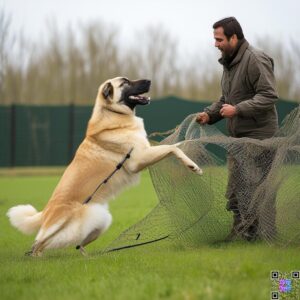Introduction
The Anatolian Shepherd is a remarkable breed, known for its impressive size, unwavering loyalty, and exceptional guarding abilities. These versatile canines have captured the hearts of many, and with the right training and guidance, they can become cherished companions and reliable guardians. In this comprehensive guide, we’ll delve into the intricacies of training an Anatolian Shepherd, ensuring you have the knowledge and tools to unlock their full potential.
Anatolian Shepherds: An Breed Overview

The Anatolian Shepherd is a large, muscular breed that originated in the rugged Anatolian region of Turkey. These dogs were historically used as livestock guardians, protecting flocks from predators and ensuring the safety of their herds. With their imposing stature, thick coats, and keen senses, Anatolian Shepherds are well-equipped to take on this demanding role. Anatolian Shepherds are known for their independent and aloof nature, which can present unique challenges during the training process. However, with patience, consistency, and a deep understanding of their instincts, you can cultivate a strong bond with your Anatolian Shepherd and guide them towards becoming a well-behaved and obedient companion.
Preparing for an Anatolian Shepherd: Laying the Foundation
Before bringing an Anatolian Shepherd into your home, it’s essential to thoroughly research the breed and ensure you’re prepared to meet their specific needs. This includes understanding their temperament, physical characteristics, and the level of commitment required to provide them with a fulfilling life.
Choosing an Anatolian Shepherd Puppy: When selecting an Anatolian Shepherd puppy, look for a reputable breeder who prioritizes the health, temperament, and socialization of their litters. Meet the parents and observe the puppy’s interactions with their siblings and the breeder to get a sense of their personality and potential.
Setting Up the Home Environment: Anatolian Shepherds require ample space, both indoors and outdoors, to thrive. Ensure you have a secure, fenced-in yard and a comfortable living space that can accommodate their large size and active nature. Invest in high-quality training equipment, such as a sturdy leash, a well-fitted harness, and durable toys to engage their natural instincts.
Fundamental Training for Anatolian Shepherds
Effective training is crucial for Anatolian Shepherds, as it helps to channel their independent spirit and instinctive behaviors in a positive direction. Begin with socialization and obedience training, laying the groundwork for a well-rounded and well-behaved companion.
Socialization and Obedience Training: Expose your Anatolian Shepherd puppy to a variety of people, animals, and environments from an early age to help them develop confidence and a calm, friendly demeanor. Simultaneously, focus on teaching basic obedience commands, such as “sit,” “stay,” and “come,” to establish a foundation of trust and respect.
Housetraining and Crate Training: Anatolian Shepherds can be challenging to housetrain due to their independent nature, but with patience and consistency, you can successfully teach them to eliminate in designated areas. Crate training can also be a valuable tool, providing a safe and secure space for your Anatolian Shepherd when you’re unable to directly supervise them.
Basic Commands and Tricks: In addition to obedience training, consider teaching your Anatolian Shepherd a variety of basic commands and tricks, such as “down,” “heel,” and “shake.” These exercises not only strengthen the bond between you and your dog but also help to reinforce their training and keep them mentally stimulated.
Specialized Training for Anatolian Shepherds
Anatolian Shepherds were bred to excel as livestock guardians, and their natural instincts can be harnessed through specialized training. Explore these unique training opportunities to bring out the best in your Anatolian Shepherd.
Guarding and Herding Instincts: Capitalize on your Anatolian Shepherd’s innate guarding and herding abilities by providing them with opportunities to practice these skills. Consider enrolling them in herding or livestock guardian training programs, where they can learn to protect and manage flocks or herds under the guidance of experienced trainers.
Agility and Obedience Competitions: While Anatolian Shepherds may not be the most natural competitors, participating in agility or obedience trials can be a rewarding experience for both you and your dog. These activities help to strengthen your bond, enhance your Anatolian Shepherd’s training, and provide a fun and enriching outlet for their energy and intelligence.
Maintaining an Anatolian Shepherd’s Health and Well-being
Ensuring the health and well-being of your Anatolian Shepherd is crucial for their overall happiness and longevity. Proper nutrition, regular exercise, and attentive grooming are all essential components of caring for these majestic canines.
Nutrition and Diet: Anatolian Shepherds require a high-quality, protein-rich diet to support their large size and active lifestyle. Work closely with your veterinarian to determine the appropriate feeding schedule and portion sizes for your individual dog.
Exercise and Activity Needs: Anatolian Shepherds are highly active and require ample daily exercise to maintain their physical and mental well-being. Provide them with opportunities for long walks, hikes, and playtime in a secure, fenced-in area to help them burn off excess energy and stay healthy.
Grooming and Coat Care: Anatolian Shepherds have a thick, double-layered coat that requires regular grooming to prevent matting and maintain a healthy appearance. Invest in high-quality brushes and combs, and be prepared to dedicate time to brushing your Anatolian Shepherd on a weekly basis.
Addressing Common Behavioral Challenges
While Anatolian Shepherds are generally well-behaved and loyal companions, they can sometimes exhibit challenging behaviors that require proactive training and management.
Excessive Barking: Anatolian Shepherds are known for their tendency to bark, often as a means of communicating or guarding their territory. Work on teaching them the “quiet” command and provide them with ample opportunities to express their natural guarding instincts in a constructive manner.
Separation Anxiety: Anatolian Shepherds can develop separation anxiety due to their strong attachment to their owners. Gradually acclimate your dog to being left alone, and consider providing them with interactive toys or calming supplements to help ease their anxiety.
Aggression and Dominance Issues: Anatolian Shepherds can sometimes display aggressive or dominant behaviors, particularly towards other animals or unfamiliar people. Consistent training, socialization, and positive reinforcement can help to mitigate these tendencies and foster a well-adjusted, confident companion.
Anatolian Shepherds in Different Environments
Anatolian Shepherds can thrive in a variety of living situations, from family homes to rural settings, as long as their specific needs are met.
Living with Families: Anatolian Shepherds can make excellent family companions, provided they receive early socialization and training. Introduce them to children gradually and supervise all interactions to ensure the safety of both the dog and the child.
Integrating with Other Pets: Anatolian Shepherds may not always get along well with other pets, especially smaller animals. Careful introductions and ongoing supervision are crucial when integrating an Anatolian Shepherd into a household with other furry friends.
Outdoor and Rural Settings: Anatolian Shepherds are well-suited to outdoor and rural environments, where they can fully embrace their guarding and herding instincts. Ensure they have access to a secure, fenced-in area and provide them with ample opportunities to patrol and protect their territory.
How to Train an Anatolian Shepherd
Training an Anatolian Shepherd can be a rewarding experience, but it requires patience, understanding, and a bit of strategy. These magnificent dogs are known for their loyalty, intelligence, and protective instincts. Whether you’re welcoming a 2-year-old Anatolian Shepherd into your home or starting with a puppy, knowing how to train them effectively is crucial. In this guide, we’ll cover everything from understanding the breed to advanced training techniques, ensuring you have all the tools you need for success.
Advanced Training Strategies
Teaching Commands: Sit, Stay, Come
Once your dog has mastered basic commands, it’s time to introduce more advanced ones like “down” or “leave it.” Use the same principles of positive reinforcement—reward them immediately after they perform the command correctly. Consistency is key; practice these commands regularly in different settings.
Agility Training for Anatolian Shepherds
Agility training can be an excellent way to engage your Anatolian Shepherd mentally and physically. Set up an obstacle course in your yard using cones, tunnels, or jumps. Encourage your dog to navigate through the course using treats as motivation. This not only enhances their physical abilities but also strengthens the bond between you two.
Addressing Behavioral Issues: Barking, Digging, etc.
Behavioral issues can arise if not addressed early on. If your dog barks excessively or digs in the yard, identify the triggers behind these behaviors—boredom or anxiety might be culprits. Provide ample exercise through walks or playtime to burn off excess energy. For digging specifically, redirect this behavior by providing designated digging spots filled with toys.

FAQs
1- How much exercise does an Anatolian Shepherd need?
Anatolian Shepherds are highly active and require at least 60-90 minutes of daily exercise, including walks, playtime, and opportunities to run in a secure, fenced-in area.
2- Are Anatolian Shepherds good with children?
With proper socialization and training, Anatolian Shepherds can make excellent family companions. However, it’s essential to supervise all interactions between the dog and children to ensure everyone’s safety.
3- Do Anatolian Shepherds bark a lot?
Yes, Anatolian Shepherds are known for their tendency to bark, often as a means of guarding their territory or communicating. Training your dog to respond to the “quiet” command can help manage excessive barking.
4- How much grooming do Anatolian Shepherds require?
Anatolian Shepherds have a thick, double-layered coat that requires regular brushing, typically 1-2 times per week, to prevent matting and maintain a healthy appearance.
5- Can Anatolian Shepherds live in apartments?
While Anatolian Shepherds can adapt to apartment living, they thrive best in homes with access to a secure, fenced-in yard where they can freely move and exercise. Providing them with ample daily exercise and mental stimulation is crucial in an apartment setting.
Conclusion
Training an Anatolian Shepherd requires patience, dedication, and a deep understanding of the breed’s unique characteristics and instincts. By mastering the fundamentals of socialization, obedience, and specialized training, you can cultivate a strong bond with your Anatolian Shepherd and help them reach their full potential as loyal, well-behaved companions.Remember, every Anatolian Shepherd is an individual, and their training journey may require adjustments and adaptations to suit their unique personality and needs. With the right approach, you can unlock the true essence of this majestic breed and enjoy a lifetime of rewarding experiences together.
